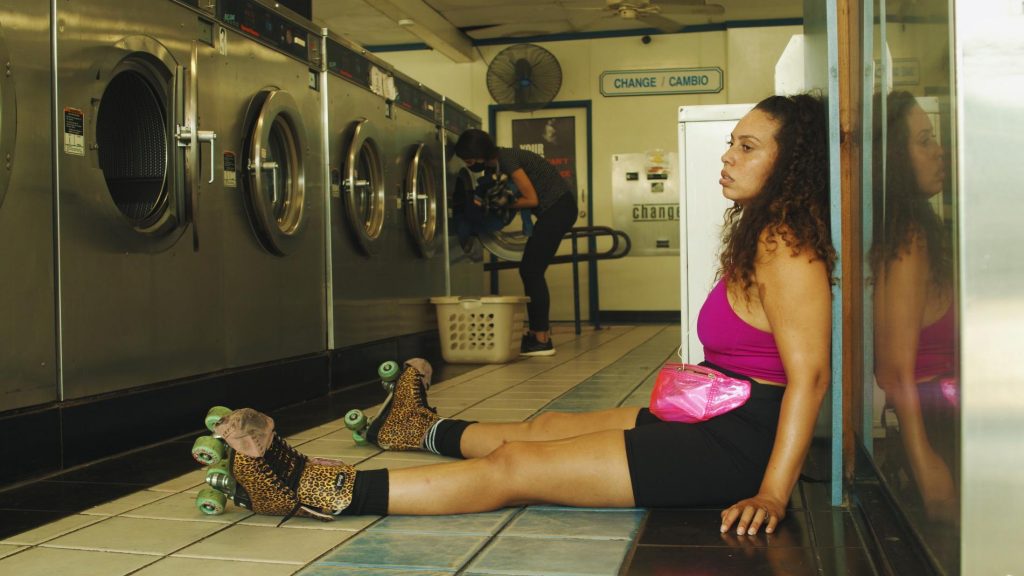For the second year in a row, the South by Southwest Film Festival has gone virtual; coinciding with the one-year anniversary of the COVID-19 pandemic truly beginning to upend life as we know it. It can feel daunting to confront day-to-day life, let alone a lengthy film festival, while also surviving this health crisis. However, art has always served as a helpful way of not just escaping the world’s turmoil but understanding it. Through many SXSW 2021 movies, one can find ways of coping with the ongoing pandemic.
These films can remind us of the joys of face-to-face human interactions; of the broader world out there just waiting to be explored again; of the tiny details of everyday life we may have taken for granted. With these reminders, the news of vaccines rolling out, and even the sight of new movies getting made (like several features debuting at SXSW 2021), I certainly feel a little more hopeful confronting the future. Hopefully, after reading the first of three write-ups on this year’s SXSW slate, maybe you will too.
The Oxy Kingpins

As The Oxy Kingpins begins, Alan explains in voice-over that he used to be a big-time drug dealer.
This is no set-up for a joke. Alan, prior to serving an extended prison sentence, was indeed a wealthy drug dealer in Miami, Florida. The drug he got so rich from? Oxycotin. A highly-addictive pain-killer prescribed by doctors, it’s become the source of an American epidemic. Now, Alan is part of a lawsuit being drummed up against the biggest pharmaceuticals in the world.
Much of The Oxy Kingpins documentary is framed from the perspective of the lawyers behind this case. Through sequences of these lawyers preparing for the trial, director Brendan Fitzgerald overestimates the audiences tolerance for legal jargon. No matter how passionately these lawyers feel about this case, there’s no getting around that they’re spectators in this epidemic. The fact that the trial isn’t scheduled to happen until April 2021 also concludes their storyline on an anti-climactic note.
On the other hand, the production fares much better just listening to the testimonies of people who have been immersed in the world of Oxycotin. This is especially true of Anna; a former addict who shares haunting story about how this drug and her own actions capsized her life. Fitzgerald does solid work framing these interviews as not misery porn but something more specific and personal.
By going in this direction, The Oxy Kingpins paints a vivid portrait of the people pharmaceutical companies would rather shove under the rug.
Anecdotes from Alan and others involved in his drug smuggling also prove fascinating if only to hear just how easy it was procure this drug. Stories from the anonymous figure Doug are especially compelling. Even with his face blacked out and his voice distorted, there’s such haunting remorse in Doug’s stories. You can tell that his actions have genuinely stuck with him; especially when he recounts how a young man he sold drugs to eventually died.
The Oxy Kingpins tackles an important topic in a messy fashion. While some of its interviews register as truly impactful, there’s still too much emphasis on forgettable third-party figures. Taken as a whole, I’m also unsure the production has anything utterly new to say about America’s opioid crisis. But there are still a fair number of interesting interviews to be found in here that do examine the humanity at risk in any kind of drug craze.
Introducing, Selma Blair

You know Selma Blair for her work in movies like Legally Blonde and Hellboy.
But as the title of Introducing, Selma Blair makes clear, this documentary wants to introduce viewers to a whole other side of this performer. Specifically, Introducing, Selma Blair is an unflinching look at the actor’s day-to-day life living with multiple sclerosis. This disease has impaired the physical and mental capabilities of Blair to such a severe degree that she’s decided to take part in a risky stem cell transplant procedure to try and mitigate the symptoms.
It’s a hazardous move, but as Introducing, Selma Blair makes clear, living with MS has already made Blair’s existence precarious. Director Rachel Fleit doesn’t shy away from showing interview moments where Blair’s Ms becomes apparent; like when her speech becomes slurred or the difficulties she has walking. Rather than sensationalize these aspects of Blair’s life, Fleit manages to normalize them.
Just as the old axiom says that putting a name to something robs it of its power, so too does Blair’s openly vulnerable portrayal here dilute the dehumanizing stigmas surrounding those with MS.
Fleit’s nuanced portrait of Blair is further enhanced by her wise decision to frequently return to scenes that show Blair just living her life divorced from MS. Scenes of Blair being a fun mom to her son have an authentic charm as do poignant scenes with her sister. The fact that Fleit captures multiple years of Blair’s life allows the viewer to see such thoughtful changes in Blair’s view of the world; particularly in regards to her relationship with her mother. A clearly contentious dynamic ebbs and flows over the course of Introducing, Selma Blair as her mom’s health deteriorates.
That’s the kind of nuance that makes Introducing, Selma Blair not only a refreshing look at living with MS but also just a good documentary in its own right. It’s also a quality that renders the film an effective tearjerker, particularly once Blair begins preparing for her medical procedures. A scene of Blair’s son shaving her head in preparation for chemotherapy, goodness, there’s no way that won’t get a lump in your throat. While Blair notes early on that her career as an actor was limited to supporting roles, Introducing, Selma Blair allows her to grab the spotlight in a fascinating and unflinching manner.
I’m Fine (Thanks for Asking)

Danny and her daughter Wes are camping.
At least, that’s what Danny (Kelley Kali) has told Wes (Wesley Moss). In reality, they’ve been camping on the side of the road because they don’t have a home to live in. But that should all change today since Danny is about to receive the last $200 she needs for an apartment. Getting that money turns out to be a whole lot more complicated than expected, though. I’m Fine (Thanks for Asking) proceeds to follow Danny over a day as she tries to get the money necessary to end her and Wes’ “camping” trip.
Writer-directors Kelley Kali and Angelique Molina (who penned the script with Roma Kong) kick-off I’m Fine (Thanks for Asking) in an in media res fashion in several ways. For one thing, Danny has already lost her husband (and Wes’s father), Sam, a few months before the story begins. For another, this film takes place during the COVID-19 pandemic; but it’s at a point where people are trying to navigate some form of normalcy during the health crisis. Then there’s the fact that every side character Danny runs into is in the middle of their own adventures. They don’t just exist to share dialogue with her.
Kali and Molina effectively convey the idea that plenty of living has already happened in the universe of I’m Fine (Thanks for Asking) before the audience dropped by. The filmmakers are also skilled at subtle things, like finding tension in the little inconveniences. Danny’s whole struggle for $200, for instance, comes about simply because a customer accidentally stiffed her.
Meanwhile, social commentary is similarly quiet but effective; like the sight of an upper-class woman whose biggest complaint is not getting wontons in her food delivery.
Compared to Danny’s day, it’s apparent that Kali and Molina are showcasing how two different economic classes have wildly disparate ideas of “hardship”.
The more broad moments of I’m Fine (Thanks for Asking) are less consistently successful; like an extended bit of broad comedy revolving around Danny and her friend Beverly trying to get off a slider while high. It aims for The Rake Effect but doesn’t quite get there. The big “All is Lost” moment is also the most heightened depiction of conflict in the entirety of I’m Fine and even involves hand-to-hand scuffle. Not only could the choreography and editing here use some fine-tuning, but it also feels like too much of a departure from the more casual manifestations of problems in the rest of the story.
More often than not, I’m Fine (Thanks for Asking) functions well as a relatable story about everyday troubles piling up. It’s also, in a welcome departure from many movies about economic hardship, entertaining to watch. You can chalk that up to amusing comedy, an engaging lead performance from Kali, and the use of dynamic imagery; such as Danny gliding down sidewalks in her leopard-print roller skates. Danny may not have been telling Wes the truth when she said they were camping, but I’m telling the truth when I say I’m Fine (Thanks for Asking) is worth seeing.
The United States vs. Reality Winner

Reality Winner was many things.
She was a 26-year-old woman. A dog owner. A military veteran. She was the owner of a pink AR-15. Oh, and she also got arrested for leaking documents that confirmed Russian intelligence tried to hack into American election facilities. The FBI immediately arrested Winner while comments from the agency and the George Attorney General painted Winner as a monster. The documentary The United States vs. Reality Winner gets more personal by following Winner’s parents as they start a campaign for the release of their daughter.
Through recurring interviews with Edward Snowden and archival footage, The United States vs. Reality Winner places its titular in the context of other historical whistleblowers. Reality Winner wasn’t the first, and as Snowden observes, she won’t be the last. But this isn’t a story about the history of whistleblowers in the United States of America. Director Sonia Kennebeck is more interested in fleshing out Winner as a person and the consequences her arrest had on her loved ones.
To that end, the production fares quite well; especially since the film has quiet touches that render Winner as more than the one-dimensional portrait painted by 24/7 news stations.
Extended looks at her diary, in which she divulges everything from frustrations with America to just neat recipes she’s found, especially lend a multifaceted look at Winner. In addition to fleshing her out as a person, these intimate examinations also make the context of her actions even more impressive. Here was not a master spy or a monster, but a person with the same ups and downs as anyone.
Snippets of Winner’s actual phone calls — apparently released a month prior to this film’s premiere — lend insight into her psyche. It isn’t just Winner that gets thoughtfully portrayed here. Both of Winner’s parents are also given plenty of time in the spotlight. Much like their daughter, they’re framed as two people trying to navigate a situation far larger than themselves.
Less successfully executed are filmed recreations of Winner’s initial FBI arrest; which play off of actual audio of Winner talking to the FBI agents. It’s not the most imaginative visual accompaniment, but at least the audio gets the job done of emphasizing Winner’s humanity. That’s clearly the crux of The United States vs. Reality Winner and it’s a quality that ends up being nicely-rendered. Reality Winner was many things and now we can add star of a solid documentary to that list.
Douglas Laman is a freelance writer providing SXSW coverage for Offcultured.
Header: I’m Fine (Thanks for Asking) | Credit: Becky Baihui Chen
